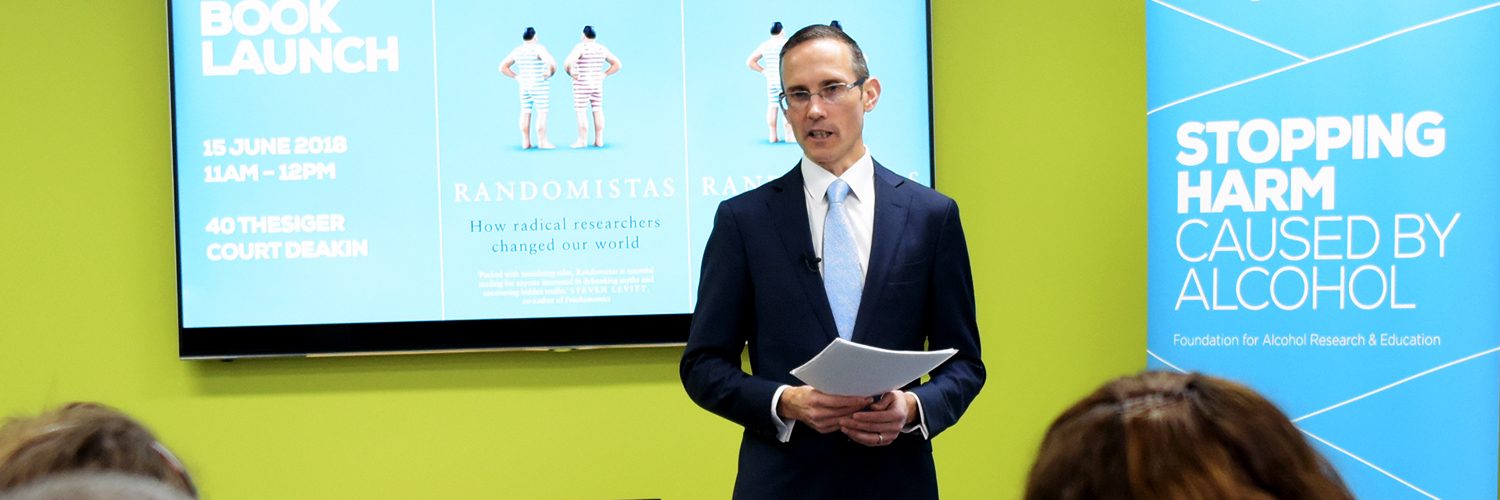Randomised tests are carried out on us every day by supermarkets, Google, online dating sites and direct marketers. Political parties use randomised trials to win elections.
But how do these tests work?
In his latest book Randomistas: How Radical Researchers Changed Our World, Andrew Leigh, federal member for Fraser and the Shadow Assistant Treasurer delves into the fascinating history of randomised trials and how they have helped shape the modern world.
To mark the release of his new book, Andrew Leigh was invited by the Foundation for Alcohol Research and Education to talk about the key findings from his book.
The following is an excerpt from that event.
So, what does a typical randomised trial look like?
Suppose we decided to test the impact of sleep on happiness by doing an experiment with the thirty or so people in this room. If each of us tossed a coin, we’d end up with about 15 people in the heads group and 15 people in the tails group. Now, imagine we asked the group to get an extra hour of sleep tonight, and then we measure everyone’s happiness tomorrow. If the people who’d tossed a coin, which came up heads, were happier tomorrow, we might well conclude that sleeping a little bit more makes you happier.
The beauty of a randomised trial is it gets around the problems that might plague an observational analysis. So, if we were to survey the room and ask each person how happy they were and how much sleep they got last night, you might have reversed causality. It might be that happy people were the ones who were organised enough to hit the pillow early and the stressed ones were the ones who because of their stress, weren’t getting enough sleep.
Randomised trials get the causal arrow right, and they have a long history in medicine.
In 1954, a randomised trial in America randomly injected 600,000 school children with either polio vaccine or salt water. The vaccine was effective, and immunisation of all American school children could, therefore, begin the following year informed by strong evidence.
The 1960’s medical researchers use randomised trials to test drugs for diabetes and blood pressure and the contraceptive pill. And in between, there’s been a ton of randomised trials that have shown that treatments are ineffective.
In fact, if you start with ten drugs that look promising in the laboratory, only one will make it to market. Nine out of ten drugs will be knocked out by either the phase one trial, the phase two trial, the phase three trial or the final market testing.
In each case, those taking the new drug are compared against people taking a fake drug, or placebo. For alleviating discomfort, the placebo effect works in surprising ways. For example, placebo injections produce a larger effect than placebo pills. Even the colour of a tablet changes the way in which patients perceive its effect. Thanks to randomised trials, we know that if you want to reduce depression, you should give the patient a yellow tablet. For reducing pain, use a white pill. For lowering anxiety, offer a green one. Sedatives work best when delivered in blue pills, while stimulants are most effective as red pills. The makers of the movie The Matrix clearly knew this when they devised a moment for the hero to choose between a blue pill and a red pill.
For my own part, randomised trials have helped to shape how I look after my health. I used to take a daily multivitamin pill until I read a synthesis of the randomised trial, evidence on longevity and vitamin supplements, suggesting that taking supplements of vitamins A, C or E was associated with slightly shorter life expectancy. Not wanting to send myself to an early grave, I stopped taking multivitamins.
Whenever I have to remove a band-aid from one of my sons, I always remind them of the randomised trial that tested the effect on pain of the fast method versus the slow method of band-aid removal. Fast produces less pain.
Randomised trials discovered a better way of getting people to turn up to doctor appointments other than fine enforcement. St Vincent’s Hospital has shown that a text message reminder that tells the patient that they will cost the healthcare system $100 if they don’t show up to their appointment are quite effective in getting patients to honour their booking.
But we need to, we need to do more, and I think it’s a matter of pushing on all fronts of public servants suggesting that random testing as well as conventional evaluation works.
However, randomised trials are only as good as the evidence.
In 1747, James Lind did a terrific randomised trial on various scurvy treatments. Twelve sailors were given six different treatments – so a pair of sailors got each treatment. You had things like vinegar and seawater, some sort of acid. And of course, the pair who took oranges and lemons recovered within a week. But then when he wrote it up, he got all of the underlying science completely wrong. It was utter hocus pocus when he tried to explain why oranges and lemons worked. So people didn’t take Lind seriously.
So randomised trials flourish where modesty meets numeracy. An experimenting society doesn’t just mean we do more rigorous evaluation, it also means we pay more attention to the facts. We are less dogmatic, more honest, more open to criticism, less defensive. We are more willing to change our theories when the data prove them wrong.
Ethically done, randomised experiments can change our world for the better.
Time to toss a few more coins?
Full transcript can be found here








Add comment